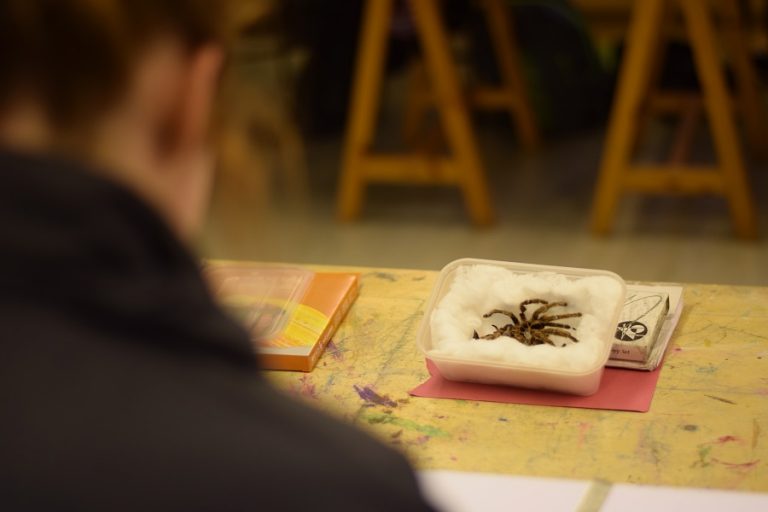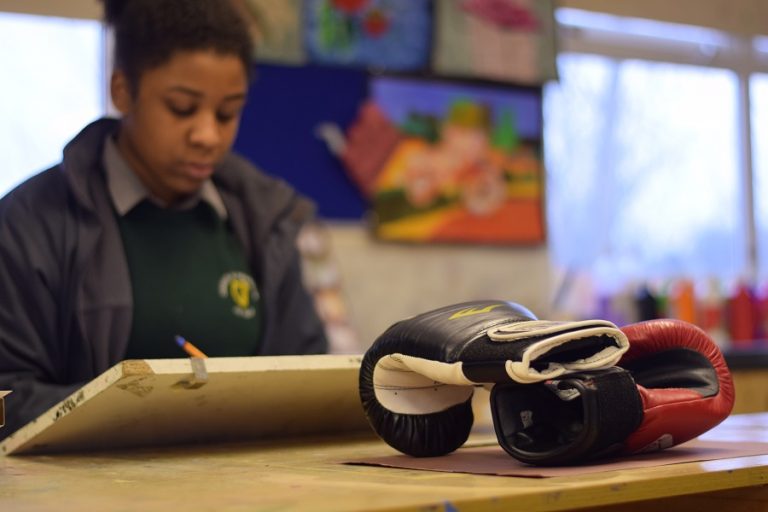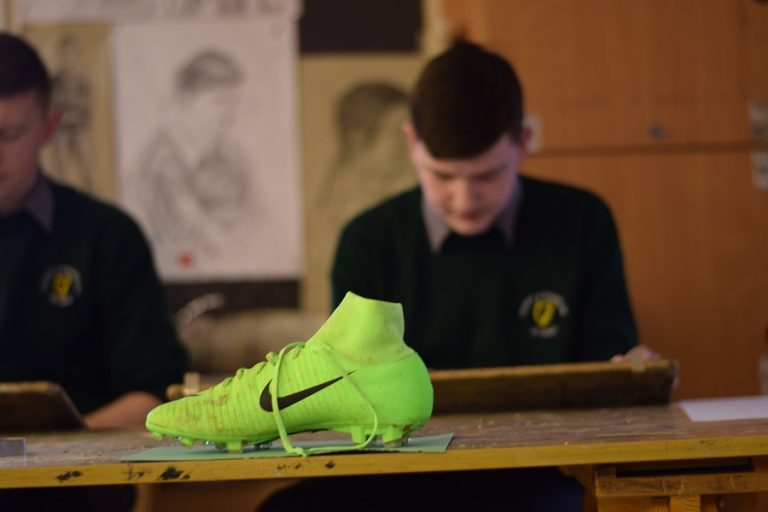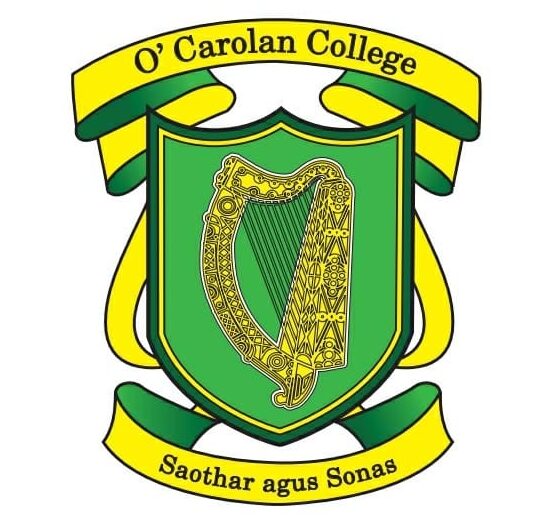Visual Art



Department Members
Kelley McCormack, Katie Reynolds
Provision of subject in the school
Art is an optional subject for First Year students. The subject must then be kept until Junior Cycle. Students may choose it as an option again on entry to Fifth Year. Only in exceptional circumstances will students who have not completed the Junior Cycle Art course be allowed to do Leaving Certificate Art. Evidence of artistic skill in the form of sketchpads or portfolios must be presented to the Art Department. Art is offered at Common level for Junior Cycle and at Higher or Ordinary for Leaving Certificate. All Transition Year and L.C.A students study Art as part of their programs.
Time Allocation
| Junior Cycle | Two double periods per week |
| Leaving Certificate | Two double and one single period per week |
| Transition Year | One double period per week |
| Leaving Cert Applied | One double period per week |
Junior Cycle Visual Art
The specification for Junior Cycle Visual Art focuses on the students’ practical and cognitive engagement with art. Students will be enabled to progressively improve their skills as an artist/ craftsperson/designer in a space that is safe for them to explore ideas and diverse processes both creatively and imaginatively. This can be achieved through the interconnected strands of the disciplines of art, craft and design. A student will experience learning in each of these three strands as they progress through their junior cycle.
Visual Art
Art, or fine art, is the expression of creative skill in a visual form. It emphasises ideas, feelings and visual qualities through imaginative and/or technical skill. Apart from the creation of artworks, fine art also encompasses the study of art through appreciation and critical discussion.
Craft is the application of a range of artistic skills and knowledge to produce artefacts of aesthetic worth. With an emphasis on processes and materials, the artefacts created may represent either traditional crafts or a more individual approach by the craftsperson.
Design is the process of planning, problem solving and creating. It can be a response to a brief, a need or a situation. Emphasising the process of planning, problem solving and completion, with drawing as a means of thinking, formal visual elements and imagery are used to communicate messages and ideas
Each element focuses on the acquisition of new knowledge, skills and values. As the student progresses through each of the strands, there will be systematic development of their fundamental knowledge, principles and values, including the key skills through each of the elements.
Junior Cycle Assessment Procedure for Art
Second year
CBA 1 From Process to Realization; Visual Art sketchpad + 1 realised work
Students, either individually or in a group, choose one scenario from a list prepared by the NCCA. They then generate ideas, experiment and develop these ideas in their Visual Art sketchpad, and realise an artwork through one of the three strands.
End of April: One review meeting
Third year
CBA 2 Communicate and reflect
Presentation Individually, students choose one scenario from a list prepared by the SEC and NCCA to generate ideas, experiments and other preparatory work in their Visual Art sketchpad. Students present this initial research and work through the two remaining strands not undertaken as part of the first Classroom-Based Assessment. This presentation of ideas and preparatory work is assessed, and students reflect on the feedback they receive. Presentation completed: Between mid-December and mid-January.
State-certified examination After Classroom-Based Assessment Two is completed, students will both significantly develop their ideas further and realise two pieces of work for the state certified examination. These pieces of work are based on the two strands not undertaken for the classroom-Based Assessment in second year. Realised works and associated development work will be submitted for SEC assessment by early May.
Leaving Certificate Art
The Leaving Certificate Art curriculum has been reviewed in recent years. The new specification is presented in three strands: Research, Create and Respond.
The three interlinked and interdependent strands of Research, Create and Respond also serve to signify the importance of the symbiotic relationship between the learner, the practical work with which they are involved and their understanding of the place of, and emphasis on, Visual Studies within their work.
There are three assessment components in Leaving Certificate Art
- Practical coursework (Booklet and 1 Artefact)
- An invigilated examination (Craft)
- A written examination (Visual Studies)
| Assessment Component | Weighting | Level |
|---|---|---|
| Practical coursework | 50% | Higher and Ordinary |
| Invigilated Examination | 20% | Higher and Ordinary |
| Written examination | 30% | Higher and Ordinary |
The Practical coursework will be covered in a specified period between January and March each year. This project involves filling a workbook with exploration and developmental artwork, culminating in the design and execution of two Artefacts. The emphasis is on using primary sources for these projects.
Transition Year Art
This year, TY students completed three projects. These projects focused on basic drawing skills, zentangles & Film Studies At the end of the year, students will present their three projects made during the year; A collection of drawings in various media, a tonal self-portrait and a film review essay.
L.C.A
This year’s 5th year Leaving Cert Applied students completed their General Education Task within Art.
– For their Key Assignment each student produced a Self Portrait using Lino printing techniques in line with the syllabus based on the theme “Individuality and Identity”.
– As part of their research for this project students visited the National Gallery in Dublin to see the Zurich Portrait Prize Exhibition.
– As part of their assessment an external examiner visits to interview the students and view their art project. This year’s LCA class did very well in their interviews, they were described as calm and confident when speaking about their projects.
Facility
O’Carolan College has a fully equipped Art room containing art materials and an interactive whiteboard.
Planning and Preparation
Department meetings are held at the beginning of each term and intermittently throughout the year. The Art teachers are members of the ‘Art Teachers Association of Ireland’, and regularly attend a variety of in career training courses throughout the year.
Resources
- Junior cycle workbook; ‘Art Odyssey’ by Grainne McKeever, Nadine McDonagh Cunningham & Catherine Kavanagh.
- Senior Cycle textbook; ‘New Appreciating Art, Visual Studies for Leaving Cert’ by Aine Ni Chartaigh and Aidan O’Sullivan.
- Mini library of reference books.
- Wall charts and diagrams.
- Interactive activity board.
- Access to internet and printer.
- Collection of student artwork on display.
- Overhead projector.
- Art and crafts tools and materials.
Art Competitions
Our art students are encouraged to take part in local & National Art competitions. These Competitions Include:
– LMETB Robert Ballagh Art & Photography Competition
– Link Credit Union Art Competition
– Texaco Childrens Art Competition
– Toyota Dream Car Art Competition
We also hold many in house OCC Art Competitions Including:
Positive Postcard Competition
Winners:
- 1st Place: Gemma Quinn 2nd Year.
- 2nd Place: Letoya Lynch 2nd Year.
- 3rd Place: Stamatis Zoumboulis 1st Year.
- Honorable Mentions: Rian Ginnity 1st year, Cara Breslin 2nd Year, Kate Butterly 1st year & Darragh Cooney 2nd Year.
Parents Association Table quiz Poster Competition
Winners:
- 1st Place: Gemma Quinn 2nd Year.
- 2nd Place: Lauren Wall 1st Year.
- 3rd Place: Sophie Meany & Eve Drennan 1st Year.
Artist of the Week
This year in the Art Department, we have started running an Artist of the week award. This award recognizes creativity, hard work and individuality in the art room, one student per week is chosen by the art department staff. A display of the student’s work is put together on the artist of the week board in the Art room and a post is made on our school’s Instagram account showcasing the excellent work.
Sketch Club
Sketch Club takes place every Monday from 1.20 – 1.55 in Room 32. All students are welcome to attend. There is a different theme/ prompt each week to challenge students.
Arts Week
As part of Arts week there was a variety of Activities happening in the Art Department:
- ‘Guess the Artist Challenge’ – A different artwork was shown on the Weekly Announcements each day and students had the opportunity to guess who the artist was. Prizes were awarded for those who got each one correct!
- ‘Lunchtime Life Drawing’ – As part of Sketch Club, there was a life drawing activity happening during Lunch.
- ‘Student Art & Craft Fair Friday’ – Several of our students had lots of arts and crafts to sell, which included paintings, drawings, handmade notebooks, crochet creations, handmade jewelry and baked goods.
- ‘Famous Artist of the day’ – At the beginning of each art class a famous artist was introduced, images of their work and a video was shown to students.
Art Outside the Classroom
Pupils are encouraged to look at and respond to art in its many forms both historically and in today’s world. To facilitate this, visits are arranged to museums, Galleries and Heritage sites in Ireland.
Organized Trips:
This year the Art Department organized a trip for art students to see ‘Three Times Out’ by Andy Warhol at the Hugh Lane Gallery, Dublin. This trip was a great opportunity for students to see such an impactful exhibition taking place in the country this year. Students from 1st, 2nd, 3rd, 5th & 6th attended along with Ms. Reynolds & Mrs. McCormack. Students had a Handout to complete based off the exhibition and a great day was had by all.
5th year LCA attended a walking tour held by SEEK URBAN (Dundalk Tourist Office) to see the murals painted around Dundalk town Centre. Students got to hear about the ideas behind the murals and get some inspiration for their own Mural project next year.
5th year LCA also attended the National Gallery in Dublin to see the Zurich Portrait Prize Exhibition. This was part of their research for their Key Assignment.
